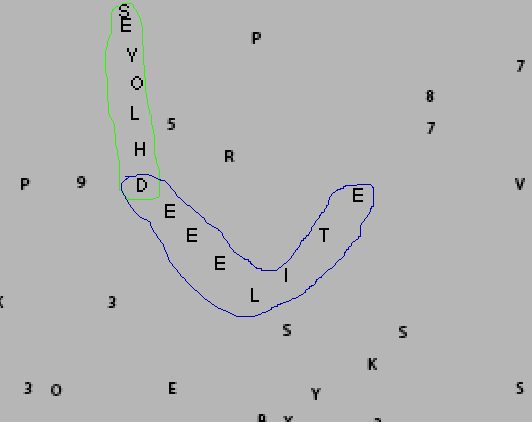Basically, yeah, there was no way I could just let Daniel Barnes' hearsay claim that there's a secret text encoded in each of Damien Hirist's spot paintings go untested last night.

But the mechanics of decoding a Hirst Code, if it does, indeed, exist, are non-trivial. Sure, there's a key painting [on which more in a second], but the whole public premise of the series is that no color repeats within a painting. Yet there are many spots in a large painting which seem nearly indistinguishable from each other. So matching up the ABC0-9 color key precisely to the hundreds of similar spots is, to use the term of the season, a challenge.
The trick, I think, is to have a computer color match the Pantone PMS codes between the Key Painting and the others. Which requires color-matched images. But Hirst's catalogue of the complete spots doesn't drop until July. So I just went ahead and grabbed one of the largest spot images I could find, and then I combined it with a Key Painting, and ran it--or babystepped it, really--through Photoshop.
Tate Modern was the single, go-to source. Tate has both a key painting, Controlled Substances Key Painting (Spot 4a) [above], and a large [2x2.5m] spot painting, Anthraquinone-1 Diazonium Chloride[below], from 1994.
A quick note on the Key Paintings: according to Tate Modern, Hirst made four of them, in different dimensions [1" to 4" spots], and they are the only Spot paintings in which the color layout is identical. Which would imply, then, that there is a single key. Though there are definitely plenty of cryptographic methods for thwarting an assumption like that, too.
Anyway, I combined the two Tate images in one Photoshop canvas, and started waving my Magic Wand over each Key Painting spot in turn, looking for matches among the larger painting's 2,050 spots. Immediately, when several A's came up, I confirmed that I still had a matching problem; theoretically, there should be one, at most. The color scales of Photoshop, the compression algorithms of JPGs and TIFFs, all of these mediations affect the precise matching between two Hirst paintings. [I just realized that Hirst's spots actually almost pre-date Photoshop itself, which first launched in 1989, and which didn't get color management until v5.0 in 1998.]
There were also matches I thought were obvious, but which PS didn't even touch. I decided to be systematic, and to err on the side of more information now, in hopes of detecting a pattern later. So I checked tolerances at 5 and 8%, and only marked spots where the central majority of the spot was highlighted. Having no letter matched up felt more validating somehow than having just one. When I did Q, I jumped to U. I did the digits, too, because they were provided, and because 733tspeak did exist in some form since the 80s, and maybe Hirst was a phone phreakin' BBS nerd in high school, who knows?
I put all the text into a separate layer, which is below. It was really late last night, like around 1:30, so I can't be entirely sure until I check it again in the daylight, but I think I have seen something.
There seems to be a structured passage in the top center of the painting. Here's a detail:

I'm going to doublecheck my work, but in the mean time, please don't go running to Gagosian trying to claim a free spot painting and pretend you are the one who found Hirst's secret message from 1994.














